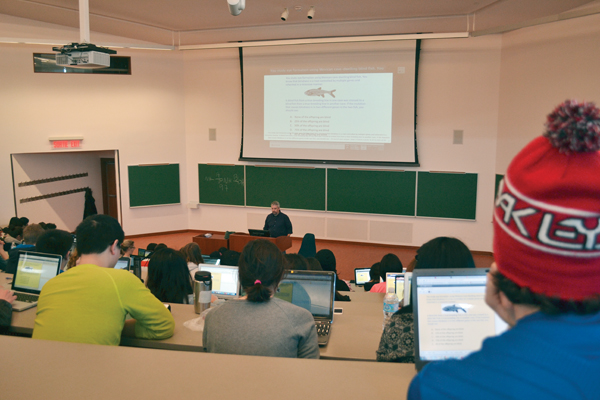Student engagement vastly improved in large classrooms
Photo: Marta Kierkus
A study by a University of Ottawa professor suggests that new technological teaching tools can help increase student engagement and classroom focus in large lecture halls at the U of O.
“I have heard many say that active learning in the large classroom is impossible,” said U of O biology professor Colin Montpetit. “I’m now convinced that much of what is said about this are myths.”
Ontario universities have the largest average class size of all provinces in Canada. According the Council of Ontario Universities, 30.7 per cent of first-year classes at the U of O had 101–250 students in 2012. The numbers generally drop in the upper years with 73.3 per cent of fourth-year classes having fewer than 30 students.
Montpetit’s research looked at the potential of the Echo360 learning system. Echo360 is described in its website as an active learning program, and it uses different forms of technology to enhance the classroom experience.
Over the semester-long study, Montpetit collected data from three different sections, for a total of 600 students. The study found a 99 per cent increase in participation, an 80 per cent reduction in failing grades, a 66 per cent increase in students taking notes, and up to a 10 per cent increase in final grades, among the many improvements observed in students’ performance.
By allowing classrooms to become digitized through the use of PowerPoint, videos, poll questions, and quizzes with the lecture, students become increasingly interactive as the classroom evolves from a passive to an active learning experience, said Montpetit.
“Students appreciated the ability to communicate with the professor in private during class without exposing themselves publicly, and to submit answers to questions anonymously,” he said.
U of O history professor Jo-Anne McCutcheon also spoke positively of Echo360. She said its most useful feature was that it was possible “for students to be able to go back to lectures to supplement their notes.”
In further improving the learning experience, McCutcheon looks forward to “flipped classes,” or those in which “the lecture is available in advance of the class … and then we can do more interactive and hands-on (activities).”
Montpetit said it took less than an hour to figure out how to use the system’s various features, and he said in class he was able to use it in different ways to “take advantage of its pedagogical benefits.”
Students’ difficulties were overcome through allocated class time where students were trained on how to properly and effectively use the program’s tools, the report said.
In a 2013 report, the E-learning group at the U of O recommended the university develop 1,000 blended courses and further expand online learning services.





